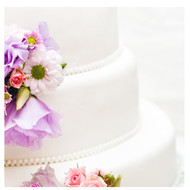Wedding Cake Traditions
13th Dec 2022
The tradition of a wedding cake dates back to ancient Roman times, when the cake was often made from wheat or barley and was broken over the bride's head as a symbol of good fortune and fertility. Over the centuries, the wedding cake has evolved into a beloved and integral part of the modern wedding celebration.
In medieval England, wedding cakes were often made from dense fruitcake and were served at the wedding feast. The cakes were typically round or square, and were often decorated with marzipan and icing. In some cases, the cakes were even stacked on top of each other to create a towering confection.
In the 16th and 17th centuries, wedding cakes became more elaborate, with multiple tiers and decorations made from sugar. These cakes were often extremely expensive, and were reserved for the wealthy elite. In some cases, the wedding cake was even considered a status symbol, with the number of tiers and the complexity of the decorations serving as a reflection of the couple's wealth and social standing. By the 19th century, the wedding cake had become a more accessible and affordable option for couples of all social classes. The Industrial Revolution brought new technologies and ingredients that made it easier to produce large and elaborate cakes, and the rise of the middle class meant that more couples could afford to have a wedding cake at their reception.
Today, the wedding cake is often a towering confection that serves as the centerpiece of the reception. It is typically made from layers of rich and delicious cake, filled with a variety of flavors and frosted with a luxurious icing. The cake is typically decorated with delicate sugar flowers, intricate piping, or other elegant embellishments, and is often topped with a small figurine of the bride and groom.
The tradition of cutting the wedding cake is a highlight of the reception. The newlyweds typically cut the first slice together, using a ceremonial knife, and then the cake is served to the guests. In some cultures, the couple may also feed each other a bite of the cake as a symbol of their commitment to nourish and support each other.
In addition to its role as a delicious dessert, the wedding cake also holds great symbolic significance. It is often seen as a representation of the couple's unity and commitment to each other, as well as their ability to provide for and nurture one another. For this reason, the wedding cake is often treated with great care and reverence, and is carefully preserved to be enjoyed on the couple's first anniversary.
The design of the wedding cake can vary greatly depending on the couple's personal style and preferences. Some couples may opt for a classic white cake with traditional frosting and decorations, while others may choose a more modern design with bold colors and unique flourishes. There are also many different flavors and fillings to choose from, allowing couples to create a cake that is truly unique and reflective of their individual tastes.
Overall, the tradition of the wedding cake remains an important and cherished part of the modern wedding celebration. It is a delicious and beautiful dessert that serves as a symbol of the couple's love and commitment to each other, and is a delightful way to end the special day.


